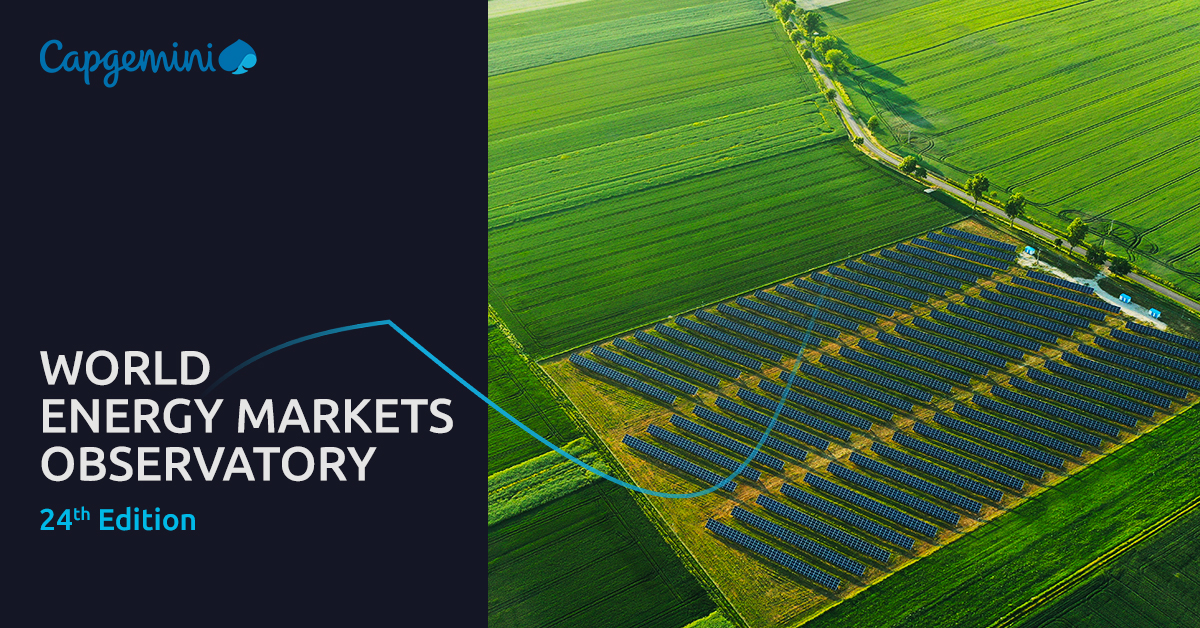Monday, June 30, 2025
Capgemini has published the 24th edition of its annual World Energy Markets Observatory (WEMO), created in partnership with De Pardieu Brocas Maffei, Vaasa ETT and Enerdata. According to the report, there is an urgency to create balance between two equally important imperatives: the security of affordable energy supply and the fight against climate change.
This year’s WEMO explores how achieving this balance is possible through the combination of short-term action and long-term decisions on the reform of the energy market design, on the sustainability of energy supplies, and on favourable financing conditions for long term green investments.
“Though energy security has been neglected in favor of the fight against climate change in recent years, the current crisis provides an opportunity for global energy markets and governments to address the two issues concurrently,” says James Forrest, global energy and utilities industry leader at Capgemini. “By activating solutions like energy reduction, solar, and wind in the short-term and continuing to unlock the biggest climate packages in history we can achieve meaningful progress between these equally important imperatives.”

Key observations and recommendations
Addressing the energy crisis with energy reduction and gas storage in the short-term
Following the Russian invasion of Ukraine, the long-term risk represented by European dependence on Russian gas has reached a breaking point. Dependence on Russian gas in Europe, especially in Germany, has compounded over the last two decades through a reduction of European gas production and an increase in gas consumption. This has been driven further still by the need to reduce greenhouse gas (GHG) emissions to advance Net Zero ambitions, closure of nuclear plants following the Fukushima incident and other economic considerations.
Presently with the forced withdrawal from Russian gas in Europe, the security of gas supply over the coming winter will depend on three factors: the filling of capacity storage facilities (EU legislation has dictated that gas storage sites must be filled to at least 80 per cent of their capacity by November 1, 2022, including the Rehden facility); identifying gas import flows1; and most importantly the effectiveness of energy reduction campaigns. Incentives for energy savings, already launched in many European countries, have the potential to trigger meaningful change.
Avoiding the renewables paradox in the mid-to-long-term
Under new EU plans to accelerate the rollout of renewables to achieve independence from Russian supply and electrification of the economy, an additional €210 billion will be needed for energy investment between now and 2027. At present, wind and solar technologies are the most promising solutions2 .
According to Colette Lewiner, energy and utilities senior advisor at Capgemini: “A careful balance needs to be struck. This means making the right bets for short-term solutions like solar and wind, while for the longer term building third generation large nuclear plants or SMRs3 in countries that can develop such programs. We need to be realistic about emerging solutions and the impact they can deliver. For instance, for economic and technical reasons, hydrogen is not on track to fulfil its net zero role by the mid-century. Therefore, green hydrogen should be reserved for industries where CO2 is difficult to abate.”
Of the renewable solutions available, solar has significant growth potential because of advances with innovative materials and methods to maximize solar energy such as bifacial cells, integrated lenses, and reverse solar panels, which can generate electricity at night. Solar sites are also more palatable to local communities when compared with wind.
However, currently 75 per cent of all photovoltaic (PV) solar panels come into the EU from China, leading, over the last decade, to the decline of EU domestic PV production. Europe must be careful not to replace Russian gas dependency by a dependency on players like China for key energy transition components like PV panels, rare earth and rare metals, cites the Observatory. European governments should create the right technical, financial, and regulatory conditions to develop domestic high end critical industries like PV panel and batteries production to regain sovereignty. In addition, bold electricity market reform should be agreed upon to encourage low-carbon generation investments.
Meanwhile, nuclear power is undergoing a renaissance, recognized as a domestic energy source central to the decarbonization of electricity and stability of the electricity grid, and in the short-term countries like Germany and Belgium should keep existing reactors open. According to the report, in the mid-term, governments in the UK, US, Japan, EU, and China should continue to build nuclear plants, while long-term remuneration systems for nuclear electricity should be put in place to encourage private players to invest in this industry
The energy crisis has also triggered a delay to the closure of coal, which is increasing CO2 emissions. Carbon Capture Usage and Storage (CCUS) technologies are an essential tool for managing these emissions and implementation and investment in CCUS plants must be accelerated. In 2021, 97 new CCUS operating plants were announced; the US and Europe account for three-quarters of all projects in development. Investment must continue as Carbon Capture capacity needs to increase by 2030 to align with a pathway to net zero by 2050; in 2021 annual carbon capacity having only reached 40 MtCO2.
Doubling down on climate action
The geopolitical disruption has reinforced the need in Europe to develop domestic energies like renewables, and nuclear for those countries that can develop such programs. Though the use of coal has increased and GHG emissions in 2022 and 2023 are likely to be higher than in 2021, there are two factors that could counteract its impact. First, the effectiveness of energy conservation could deliver significant impact on GLG emissions. Secondly, the global economic slowdowns of H2 2022 are likely to lower energy consumption and GHG correlated emissions.
Despite these trends the political will to combat climate change is still present and growing from the largest global emitters, evidenced by packages from the EU like Fit for 55 and REPowerEU, the $430 billion Inflation Reduction Act from the U.S. Joe Biden administration, and updated national climate plans from the likes of India.
What about the impacts to the Canadian market in particular? Tom Mosseau, vice president and utilities leader at Capgemini Canada, has some specific opinions on priorities in the Canadian energy market.
Electrification inclusive of electric vehicles will be a key business priority for Canada’s energy market, according to Mosseau. “However, the electrification expectations set out for governments exceeds the capabilities of all utilities across the country. To support the energy transition nationally, the government will need to establish easy wins with utilities in the electrification space and establish a more pragmatic electrification plan.”
Mosseau explains that accelerating Canada’s energy transition will require enhanced data and analytics in order to modernize, expand the capacity and improve the reliability of smart meters and smart grids.
“As it stands, the nation’s current carbon tax is not a viable solution. Both businesses and consumers must be given a more gradual, financially-friendly transition from oil and gas without facing the penalties at the gas pumps,” says Mosseau. “With this in mind, there needs to be a clear timeline for grid advancements, smart meter rollout and improved insights-gathering across every province while mitigating the existing impacts of oil and gas.”
For more information and to read the complete report, click here.
Featured image: Bill Oxford/Unsplash.











